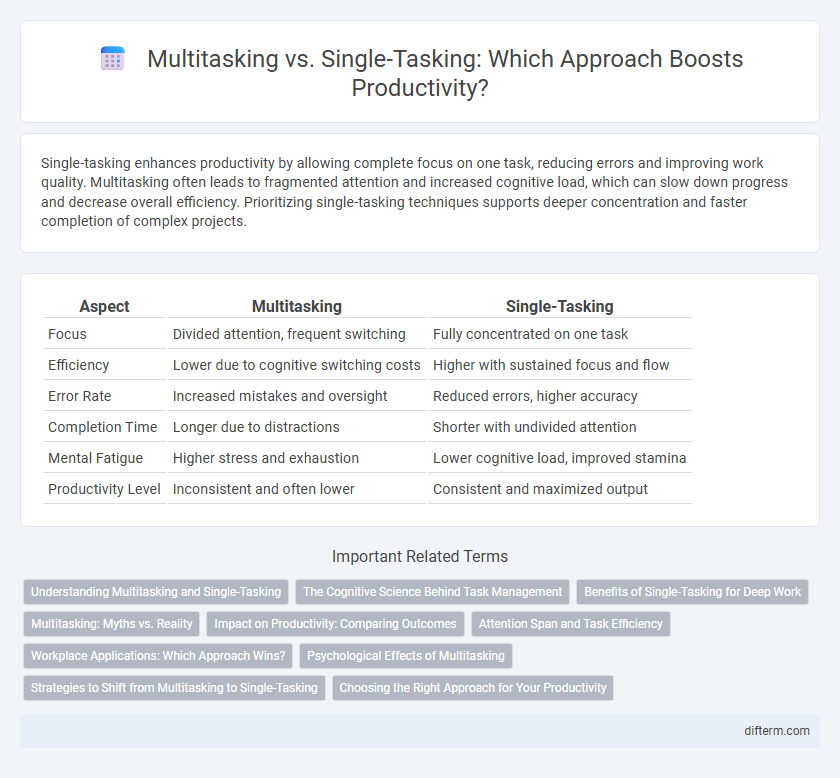Single-tasking enhances productivity by allowing complete focus on one task, reducing errors and improving work quality. Multitasking often leads to fragmented attention and increased cognitive load, which can slow down progress and decrease overall efficiency. Prioritizing single-tasking techniques supports deeper concentration and faster completion of complex projects.
Table of Comparison
| Aspect | Multitasking | Single-Tasking |
|---|---|---|
| Focus | Divided attention, frequent switching | Fully concentrated on one task |
| Efficiency | Lower due to cognitive switching costs | Higher with sustained focus and flow |
| Error Rate | Increased mistakes and oversight | Reduced errors, higher accuracy |
| Completion Time | Longer due to distractions | Shorter with undivided attention |
| Mental Fatigue | Higher stress and exhaustion | Lower cognitive load, improved stamina |
| Productivity Level | Inconsistent and often lower | Consistent and maximized output |
Understanding Multitasking and Single-Tasking
Multitasking involves switching between multiple tasks rapidly, which often reduces overall efficiency due to cognitive overload and increased error rates. Single-tasking, by concentrating on one task at a time, enhances focus and improves the quality of work by minimizing distractions. Research shows that single-tasking can boost productivity by up to 40% compared to multitasking, as it allows deeper engagement and faster completion of complex tasks.
The Cognitive Science Behind Task Management
Cognitive science reveals that multitasking significantly reduces productivity by increasing cognitive load and causing frequent task-switching, which impairs working memory and attention control. Single-tasking enhances focus, enabling deeper information processing and better problem-solving capabilities. Studies show that maintaining sustained attention on one task reduces mental fatigue and improves overall task performance.
Benefits of Single-Tasking for Deep Work
Single-tasking enhances productivity by promoting sustained concentration, which facilitates deeper cognitive processing and higher-quality outcomes. Studies show that focusing on one task at a time reduces mental fatigue and errors compared to multitasking, improving efficiency and creativity. Embracing single-tasking aligns with the principles of deep work, enabling professionals to achieve complex problem-solving and master new skills more effectively.
Multitasking: Myths vs. Reality
Multitasking is often praised as a productivity booster, but research shows it can reduce efficiency by up to 40%, as the brain struggles to switch between tasks and maintain deep focus. Contrary to popular belief, multitasking leads to increased errors and longer completion times compared to single-tasking, which promotes sustained attention and better quality output. Understanding the cognitive limitations of multitasking helps individuals and organizations prioritize focused work for enhanced performance and reduced mental fatigue.
Impact on Productivity: Comparing Outcomes
Single-tasking enhances productivity by enabling deeper focus, reducing cognitive switching costs, and increasing task accuracy. Multitasking often leads to fragmented attention, resulting in longer completion times and higher error rates. Studies show that individuals who prioritize single-tasking achieve up to 40% greater efficiency compared to those frequently engaged in multitasking.
Attention Span and Task Efficiency
Single-tasking significantly improves attention span by reducing cognitive load and minimizing distractions, leading to higher task efficiency. Multitasking often fragments focus, causing frequent task-switching that depletes mental resources and reduces overall productivity. Research shows that maintaining sustained attention on a single task boosts work quality and completion speed.
Workplace Applications: Which Approach Wins?
Single-tasking in workplace applications consistently outperforms multitasking by enhancing focus, reducing cognitive overload, and increasing task accuracy. Research shows employees who concentrate on one task at a time achieve higher productivity levels, with up to a 40% improvement in efficiency compared to those who multitask. Tools like time-blocking apps and task management software support single-tasking by minimizing distractions and optimizing workflow.
Psychological Effects of Multitasking
Multitasking often leads to cognitive overload, reducing overall productivity and impairing memory retention due to frequent task-switching. Research from Stanford University reveals that heavy multitaskers exhibit decreased attention control and increased susceptibility to distractions. Single-tasking enhances concentration and mental clarity, promoting more effective task completion and reduced stress levels.
Strategies to Shift from Multitasking to Single-Tasking
Shifting from multitasking to single-tasking involves prioritizing tasks by urgency and importance, using techniques like time-blocking to allocate focused periods for each activity. Minimizing distractions through digital detox methods and creating a dedicated workspace enhances concentration and task completion quality. Implementing mindfulness practices helps maintain sustained attention, improving overall productivity and reducing cognitive fatigue.
Choosing the Right Approach for Your Productivity
Prioritizing single-tasking enhances deep focus and reduces cognitive load, leading to improved quality and efficiency of work. Multitasking, while useful for managing routine or low-complexity tasks, often decreases overall productivity due to frequent context switching. Selecting the appropriate approach depends on task complexity and individual work style, optimizing output by aligning focus strategy with specific goals.
multitasking vs single-tasking Infographic

 difterm.com
difterm.com